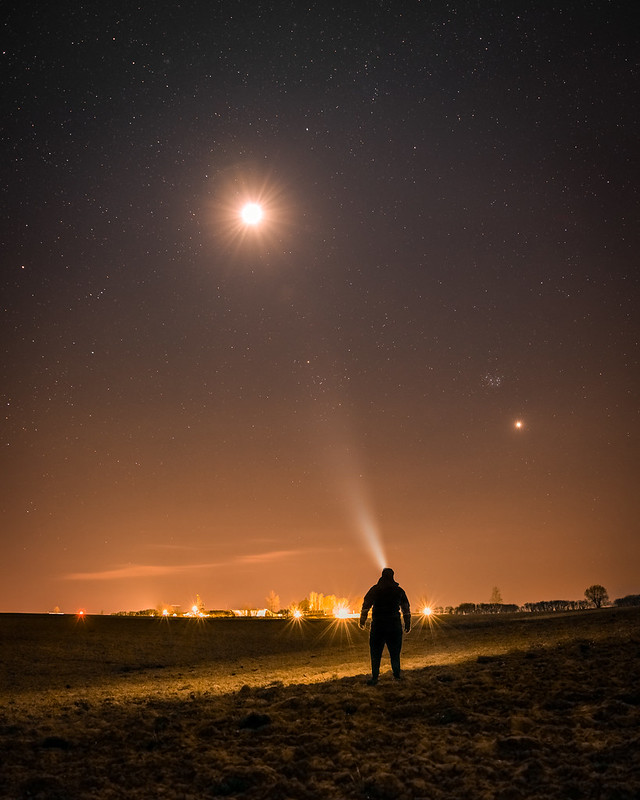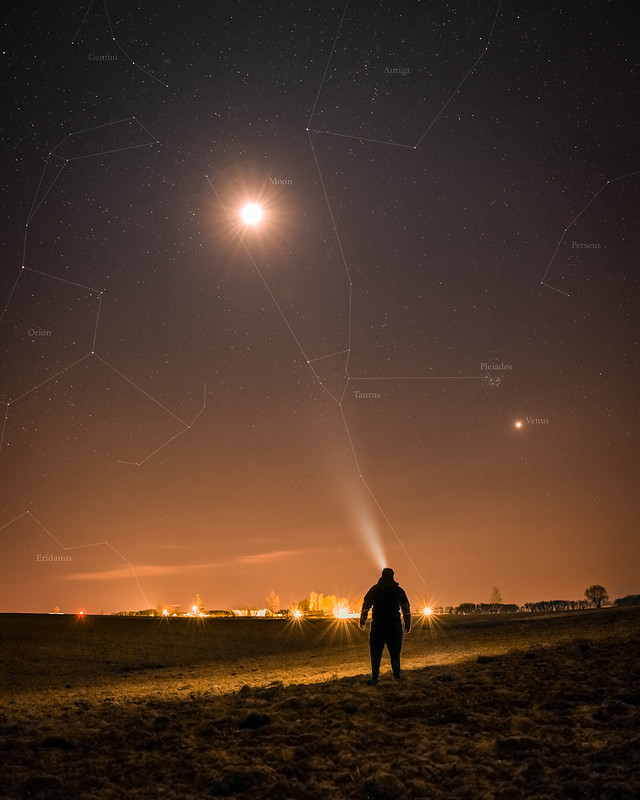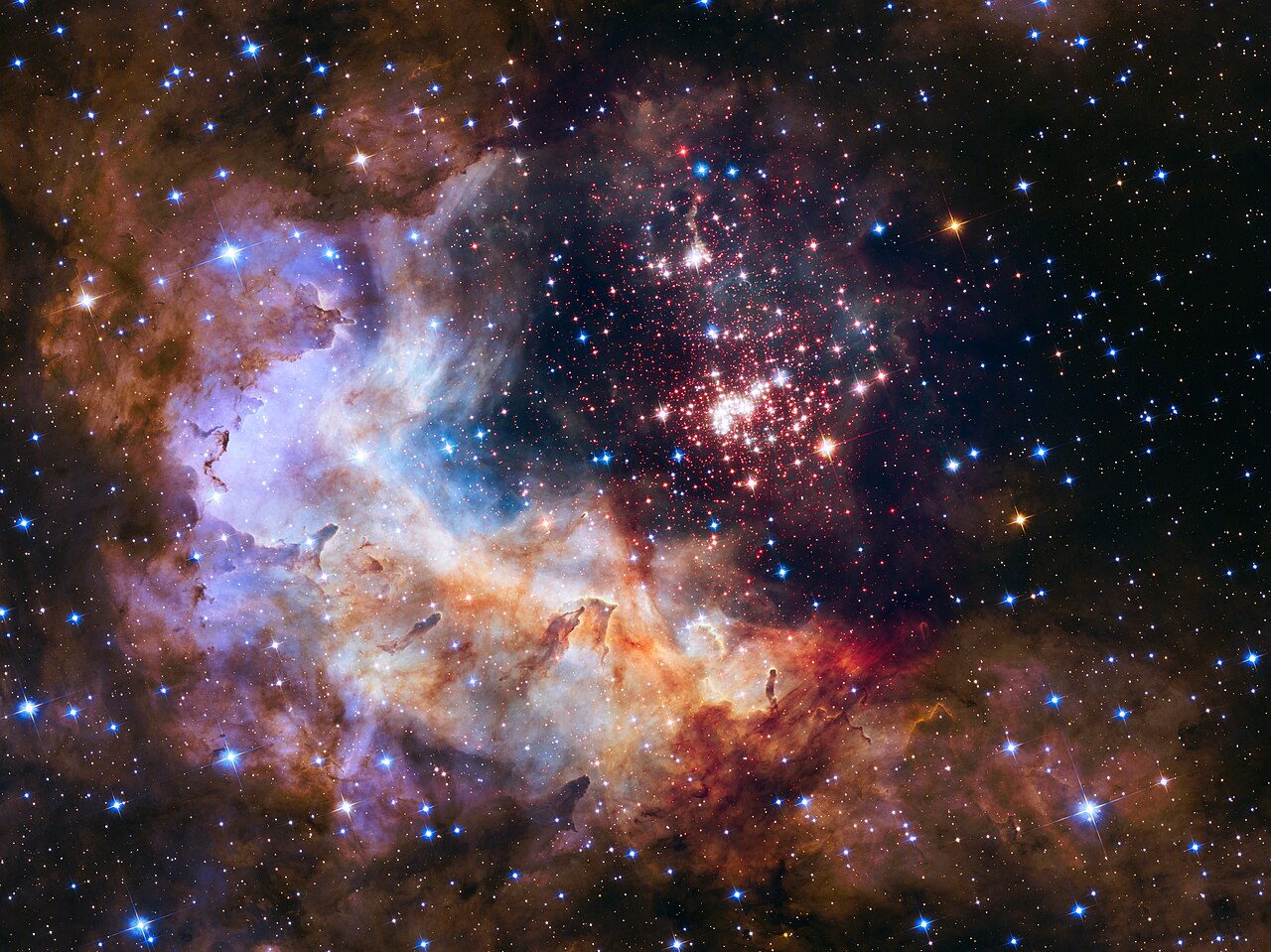Comet Atlas (C/2019 Y4) - L-RGB
Location: Toulouse, France
Exposure time : Bin1x1 : L:1h12mn ; Bin2x2 : R:18mn, G:21mn, B:21mn
200/1000 mm Newtonian telescope
Camera ZWO ASI1600MM Pro
Preprocessing with SIRIL
Comet alignment : DeepSkyStacker
Image processing with Photoshop (RGB layers alignment, L-RGB alignment)
Final touch with Lightroom
Full : https://www.astrobin.com/full/9d5uwy
Website : https://astrophoto.pagesperso-orange.fr
Submissions: 2020 March
-
olivierr31
- Ensign
- Posts: 14
- Joined: Mon Sep 28, 2015 10:00 pm
- Location: Toulouse, France
- Contact:
Re: Submissions: 2020 March
Last edited by olivierr31 on Wed Apr 01, 2020 3:22 pm, edited 1 time in total.
Re: Submissions: 2020 March
Robin_Onderka wrote: ↑Tue Mar 31, 2020 5:22 pm Venus meet Pleiades
(clean photo without labels available)
At this time you can observe an interesting encounter between Venus and Pleiades in the constellation Taurus. Visibility may be worse because of the present moon, but it also opens up new possibilities for creative photography.
The object in the background is the Remote Radar Post in Stara Ves nad Ondrejnici, Czech Republic. This RRP is (as far as I know) in operation since 1977 and the last known unit present at this station was in 2003. Current inhabitants of the base are unknown, but the place is still guarded by a military unit.
EOS 6D mark II on 24 mm | 6" f/2.8 ISO 1600 | auto portrait
Labels:
No labels:

Robin, I love your picture! Both versions of it! It is so nice to see the positions (on the day when you took your photo) and the relative brightness of these three oh-so-well-known celestial celebrities!
Ann
Color Commentator
Re: Submissions: 2020 March
markh@tds.net wrote: ↑Thu Mar 26, 2020 1:00 pm NGC 2442 - The Meathook Galaxy
Copyright Mark Hanson
NGC-2442-3smallA.jpg
Taken from El Sauce, Chile
You can see a full resilution image here: https://www.hansonastronomy.com/ngc-244 ... ook-galaxy
Thank you,
Mark Hanson
Dwarf galaxy copied from Mark Hanson's widefield image at
https://static1.squarespace.com/static/ ... 2442-3.jpg
https://static1.squarespace.com/static/ ... 2442-3.jpg
Your image also allowed me to find a nearby dwarf galaxy seemingly situated next to bright NGC 2442 at about 50 million light-years away. The dwarf galaxy, which I took the liberty of copying from you image, is partly resolved, even though it is so faint and contains so few stars and such faint clusters. It must be quite nearby.Wikipedia wrote:
Associated with this galaxy is HIPASS J0731-69, a cloud of gas devoid of any stars.[3] It is likely that the cloud was torn loose from NGC 2442 by a companion.
Thanks again!
Ann
Color Commentator
-
astrosirius
- Science Officer
- Posts: 117
- Joined: Fri Nov 23, 2012 11:17 am
- Location: Barcelona Spain
- Contact:
Re: Submissions: 2020 March
Thank you Ann, for your kinly comments to us, is really our pleasure that your like this image, and yes you're right, theren't many picitures in the web, so for this reason it was our main purpose to tryo our best, putting our skills processing. Take care, specially theses days!! Miguel and Lluís.Ann wrote: ↑Mon Mar 30, 2020 5:46 amThank you for doing this, Miguel Ángel García and Lluís Romero. I googled NGC 4535, and there existed no really good highly resolved picture of this galaxy until you posted this processed version out of Hubble data.astrosirius wrote: ↑Sun Mar 29, 2020 10:28 am NGC 4535 Black hole with surrounding arms
NGC 4535 is a barred galaxy and one of the largest galaxies in the Virgo Cluster, a massive cluster of as many as 2000 galaxies, about 50 million light-years away. Although the Virgo Cluster is not much larger in diameter than the Local Group — the galaxy cluster to which the Milky Way belongs — it contains almost fifty times as many galaxies.
The small nucleus is of type HII, meaning the spectrum resembles that of and H II region, as you can see if you make zoom, you will see it.
Data archives downloaded from Access MAST Data, for your information these are the followings archives that we have processed (15 files)
mast:HST/product/idxr28030_asn.fits -mast:HST/product/idxr28030_drc.fits-mast:HST/product/idxr28030_drz.fits-mast:HST/product/idxr28040_asn.fits -mast:HST/product/idxr28040_drc.fits-mast:HST/product/idxr28040_drz.fits
mast:HST/product/idxr28050_asn.fits-mast:HST/product/idxr28050_drc.fits-mast:HST/product/idxr28050_drz.fits
mast:HST/product/idxr28060_asn.fits-mast:HST/product/idxr28060_drc.fits-mast:HST/product/idxr28060_drz.fits
mast:HST/product/idxr28070_asn.fits-mast:HST/product/idxr28070_drc.fits-mast:HST/product/idxr28070_drz.fits
Processing by Miguel Ángel García and Lluís Romero
Tittle: NGC 4535 Black hole with surrounding arms
NGC-4535-Surrounding-Arms-Black-Hole.jpg
Thanks again!
Ann
Lluís Romero Ventura
http://astrotolva.com/
http://astrotolva.com/
-
astrosirius
- Science Officer
- Posts: 117
- Joined: Fri Nov 23, 2012 11:17 am
- Location: Barcelona Spain
- Contact:
Re: Submissions: 2020 March
M64 Going into the gravity of the Blak Hole Eye Galaxy
The Black Eye Galaxy (also called Evil Eye Galaxy and designated Messier 64, M64, or NGC 4826) is a relatively isolated.
The Black Eye Galaxy, also known as Messier 64 (M64), is a famous spiral galaxy located in the constellation Coma Berenices.
The galaxy is also sometimes called the Evil Eye Galaxy or Sleeping Beauty Galaxy. It has the designation NGC 4826 in the New General.
Catalogue Messier 64 is also notable for being composed of two counter-rotating disks, roughly equal in mass. The inner disk contains the galaxy’s spectacular dust clouds and lanes. All the stars in the Black Eye Galaxy rotate in the same direction as the gas in M64’s core region, clockwise, while the gas in the outer regions rotates in the other direction.</r>
Data archives downloaded from Access MAST Data, for your information these are the followings archives that we have processed (15 files)
mast:HST/product/idxr37030_drc.fits - mast:HST/product/idxr37030_drz.fits - mast:HST/product/idxr37040_drc.fits
mast:HST/product/idxr37040_drz.fits - mast:HST/product/idxr37050_drc.fits - mast:HST/product/idxr37050_drz.fits
mast:HST/product/idxr37060_drc.fits - mast:HST/product/idxr37060_drz.fits - mast:HST/product/idxr37070_drc.fits
mast:HST/product/idxr37070_drz.fits - mast:HST/product/n4k45yerq_cal.fits - mast:HST/product/o67108010_flt.fits
Processing by Lluís Romero
Tittle: M64 . going into the Gravity of the Black Eye Galaxy
The Black Eye Galaxy (also called Evil Eye Galaxy and designated Messier 64, M64, or NGC 4826) is a relatively isolated.
The Black Eye Galaxy, also known as Messier 64 (M64), is a famous spiral galaxy located in the constellation Coma Berenices.
The galaxy is also sometimes called the Evil Eye Galaxy or Sleeping Beauty Galaxy. It has the designation NGC 4826 in the New General.
Catalogue Messier 64 is also notable for being composed of two counter-rotating disks, roughly equal in mass. The inner disk contains the galaxy’s spectacular dust clouds and lanes. All the stars in the Black Eye Galaxy rotate in the same direction as the gas in M64’s core region, clockwise, while the gas in the outer regions rotates in the other direction.</r>
Data archives downloaded from Access MAST Data, for your information these are the followings archives that we have processed (15 files)
mast:HST/product/idxr37030_drc.fits - mast:HST/product/idxr37030_drz.fits - mast:HST/product/idxr37040_drc.fits
mast:HST/product/idxr37040_drz.fits - mast:HST/product/idxr37050_drc.fits - mast:HST/product/idxr37050_drz.fits
mast:HST/product/idxr37060_drc.fits - mast:HST/product/idxr37060_drz.fits - mast:HST/product/idxr37070_drc.fits
mast:HST/product/idxr37070_drz.fits - mast:HST/product/n4k45yerq_cal.fits - mast:HST/product/o67108010_flt.fits
Processing by Lluís Romero
Tittle: M64 . going into the Gravity of the Black Eye Galaxy
Lluís Romero Ventura
http://astrotolva.com/
http://astrotolva.com/
Re: Submissions: 2020 March
Thank you very much Ann ! Sorry for the delayed response, I was less active lately because of the pandemic and I just saw the notification. Now I will recognize it too, I wasn't aware that it was on the field. Really interesting.Ann wrote: ↑Fri Mar 13, 2020 6:18 amBobinius wrote: ↑Thu Mar 12, 2020 8:26 pm The Great Carina Nebula Region in SHO
Copyright : Bogdan Borz
A project using the "Very Small Telescope" from Chilescope.
Nikon 200mm
Camera FLI Proline 16200 at -30°
Astrodon filters 3nm Ha, SII, OIII
02/25/2020
Ha 16x600s
SII 15x600s
OIII 15X600s
Processing: Pixinsight v 1.8, Photoshop 2020
Full resolution: https://www.astrobin.com/full/fpn7az/0/
Beautiful, Bogdan Borz. I have just become aware of your great astrophotography.
Westerlund 2 Bogdan Borz.pngWesterlund 2 (crop). Photo: Bogdan Borz.
What I love most about your picture is that it "puts Westerlund 2 into perspective". When I looked at your picture of the Carina Nebula, I recognized everything in it except the little blue crescent at upper right. The reason why didn't recognize it is because I had never before seen a wide angle picture where we can actually see the location in the sky of this great cluster and nebula.
AnnWikipedia wrote:
April 23, 2015: NASA and ESA are celebrating the Hubble Space Telescope's silver anniversary of 25 years in space by unveiling some of nature's own fireworks — a giant cluster of about 3,000 stars called Westerlund 2. The cluster resides inside a vibrant stellar breeding ground known as Gum 29, located 20,000 light-years away in the constellation Carina. The comparatively young, 2-million-year-old star cluster contains some of our galaxy's hottest, brightest, and most massive stars. The largest stars are unleashing a torrent of ultraviolet light and hurricane-force winds that etch away the enveloping hydrogen gas cloud. This creates a fantasy celestial landscape of pillars, ridges, and valleys.
ABOUT THIS IMAGE: The brilliant tapestry of young stars flaring to life resemble a glittering fireworks display in the 25th anniversary NASA Hubble Space Telescope image to commemorate a quarter century of exploring the solar system and beyond since its launch on April 24, 1990.
Best regards,
Bogdan


